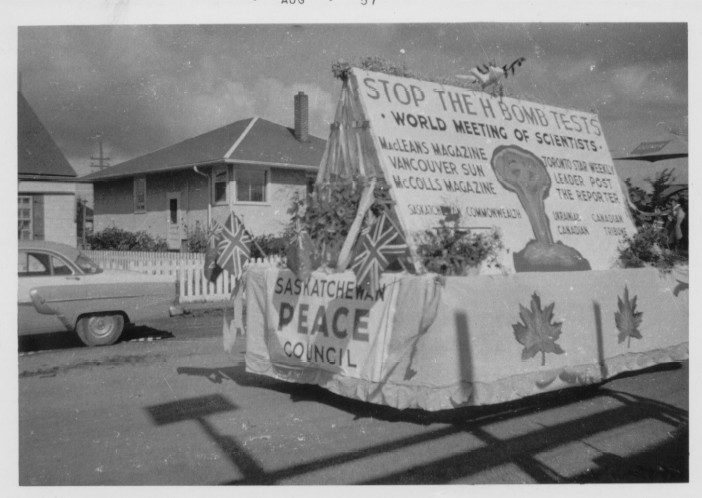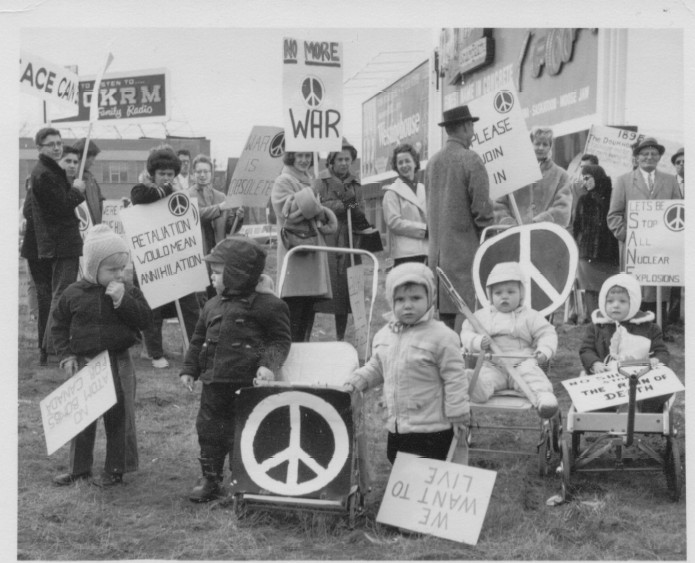|
Dorothy Morrison By: John Beeching
Dorothy Morrison born April 8 1909 died July 6 2006. Born on a homestead near Leney Saskatchewan. She started teaching school at age 17. After she married Stanley Morrison in 1940 they taught together in Indian Residential Schools in Balcarries Saskatchewan. They then moved to Regina where Dorothy nursed her mother and �mothered� her nephews and nieces as they attended high school.
Dorothy had many talents. She was an artist. As a poet she was a member of the Saskatchewan Poetry Society and had a number of her poems published by them. She also published poems and stories for children. One was called �You Can Do It.� and its theme of peace was for children.
Recognizing the new danger of a third world war arising out of imperialism of that day she and Stanley were among the first organizers who met with Dr James Endicott in 1948. Later they assisted in the set up of the Regina Peace Council (RPC) in 1949. From that time she was an active participant in all the RPC work for peace. There were numerous public meetings for Dr. Endicott and once for the Dean of Canterbury. Many leaflets on peace issues were distributed. Dorothy and Stan also helped the Regina Peace council put a float in the Regina exhibition parade; in one parade by sitting beneath the display on a flat bed of a truck and holding the display together. Strong Saskatchewan winds had threatened to make it come apart. Dorothy was one of the top signature gatherers in the ban the bomb campaign. This world-wide campaign was responsible for rousing public support in opposition to war and in particular to atomic weapons. The success of this campaign played a noteworthy role in subsequent disarmament treaties.
Dorothy and Stan then moved to BC where they both taught at Mamilillikula on Village Island. In 1963 they moved to Vancouver. Dorothy attended University of BC and graduated with a B.Ed. She taught at elementary schools in Vancouver until she retired. She continued for many years as a volunteer at Bayview school reading and listening to children.
Here involvement in peace work did not lag however. She became active in the BC Peace Council and all their campaigns. The Vietnam war 1964 to 1975 Americas longest war continued to be a focal point for all peace groups and Dorothy was at the forefront of their demonstrations and leaflet distribution. She also was in the front line of the anti Korean war (1950-1953).
Dorothy was again one of the leading signature gatherers in the Second Stockholm Appeal against nuclear weapons launched in the 1980�s. The BC Peace Council participated in the Pacific National Exhibition by opening a booth and in the parade. Dorothy�s home became a centre for the building of the peace floats. and for the making of signs to hold in the peace demonstrations and marches.
One particular float caused Dorothy to write an amusing account of its construction. It was published but I do not know where. The following is a recount of the event as I remember it. If anyone has a copy of Dorothy�s article please send it to CPS. (we think it might have been the Pacific Tribune?)
The Peace Council Makes The World
The BC Peace Council decided to use a car with the world held by four hands on the top. A sign �Peace is in your hands� was to go on a banner above the world and was supported from the front and back bumper by 2 x 2�s.
It was decided to use a weather balloon. One was purchased and blown up with a vacuum cleaner to the desired size. We then began to paint the continents on the balloon. The paint reacted with the balloon and melted it. The result was a useless balloon. We tried a new balloon covering it with papier m��ch�. We then hung the balloon from the rafters of Dorothy�s garage. Next morning we had a beautiful pear shaped world.
Attempts to push it back into a round shape resulted in the collapse of the balloon. We tried stuffing it with newsprint � no success.
Two 4x4 � inch plywood boards were slotted to the mid point on the centre of one side of each board. A circle was then cut out, the two boards placed together, covered in chicken wire and everything sprayed with a dark blue paint. Continents made of an old white sheet were then sewn to the chicken wire. Dorothy fashioned the hands of chicken wire and they were covered in papier m��ch� and painted white. The sign attached to two 2x2�s and the world and hands were now ready. We then entered the parade and met with considerable approval from the crowds that lined the parade route. It is worth noting that in those days TV reportage deftly swung the camera from the float ahead of us to the float behind us. We were never seen on TV. The demise of the world is another story.
Dorothy�s contribution to the peace movement also included travel to Bulgaria and Japan as a peace delegate. Elizabeth (Betty) Beeching and Dorothy both expert sewers made several beautiful banners used in demonstration parades.
Dorothy used her writing skills to draft countless letters to various government officials and letters to the editor in Canada and the United States. In her nineties, and legally blind, she carried on and always regretted that she couldn�t do more.
|

